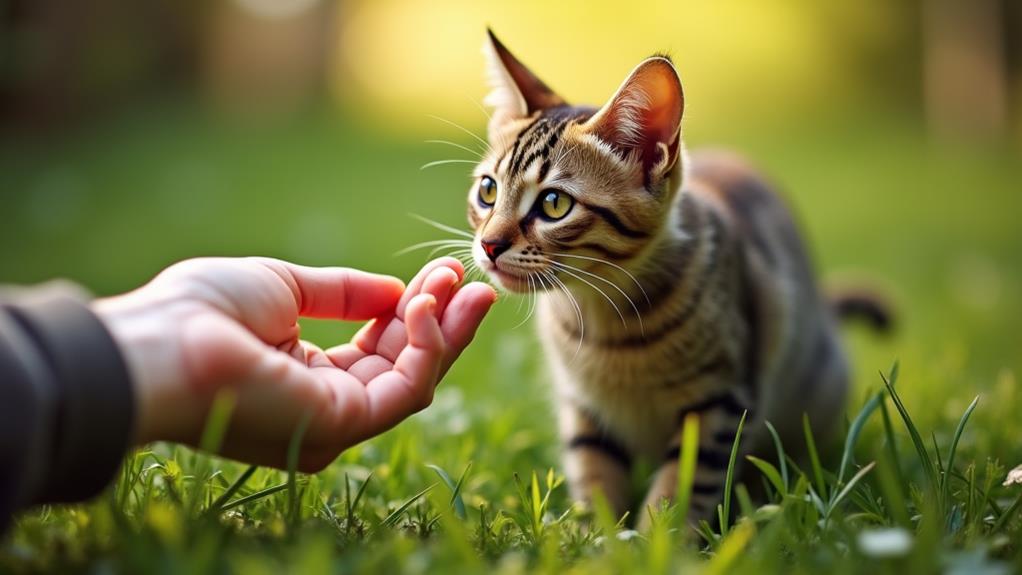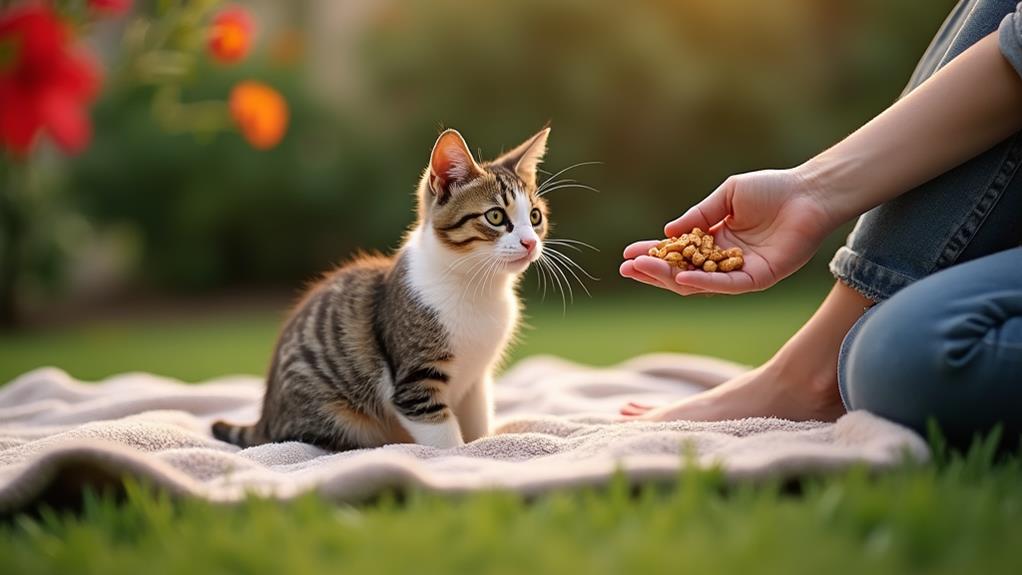How to Get a Semi-Feral Cat to Trust You: Building Trust Gradually
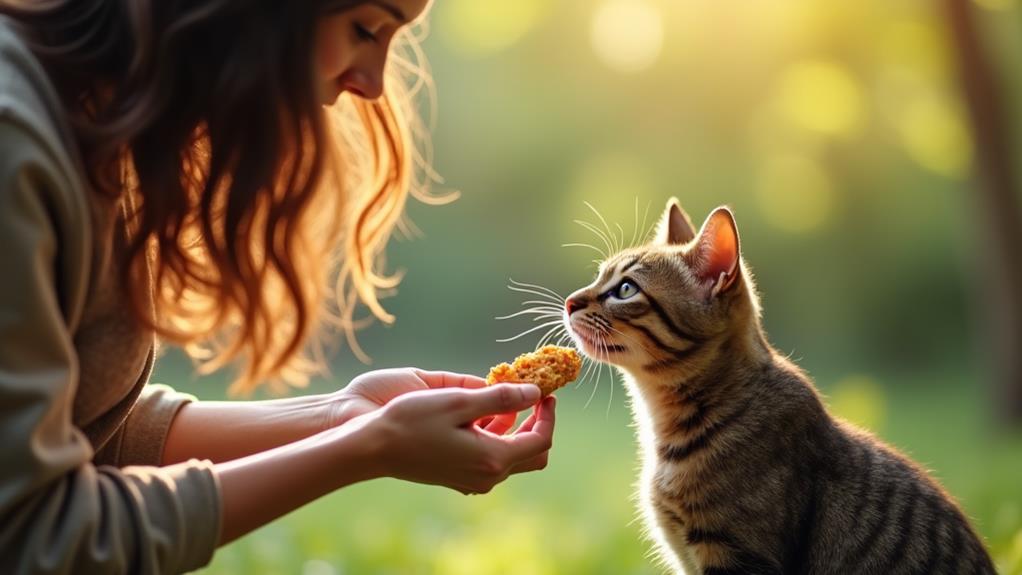
To gain a semi-feral cat's trust, start by creating a calm environment with cozy spaces where it feels secure. Establish a consistent feeding routine with strong-smelling food placed in quiet areas. Allow the cat to approach you at its own pace; remain still and use soft vocalizations. Offer treats as positive reinforcement and avoid forcing interactions. Respect its personal space and use non-threatening body language, like slow blinking, to convey safety. Calming aids, such as pheromone sprays, can also ease anxiety. Celebrate small milestones, like proximity during feeding, to reinforce trust. There's more to uncover on this bonding expedition.
Understanding Semi-Feral Behavior
Understanding semi-feral behavior is essential to successfully building trust with these cautious cats. Semi-feral cats, having had some exposure to humans, maintain a delicate balance between curiosity and caution. They might vocalize or make eye contact, signaling a potential for interaction, yet they often prefer to keep their distance. This wariness means you'll need to approach your interactions with patience and a gradual mindset.
To build trust, focus on positive reinforcement. Offer treats and engage in gentle interactions, ensuring that each encounter is calm and non-threatening. Avoid sudden movements or loud noises, as these can easily startle a semi-feral cat and set back your efforts. Your goal is to create a safe environment where the cat feels comfortable enough to investigate its curiosity without feeling pressured.
Respecting their space is vital. Pushing for contact can lead to increased anxiety and can undo any progress you've made. Instead, give the cat time to observe you from a distance. This gradual approach allows them to acclimate at their own pace, reinforcing the idea that you're not a threat. With time, patience, and understanding, you can foster a trusting relationship with a semi-feral cat.
Allowing the Cat to Approach
When building trust with a semi-feral cat, allowing it to approach you at its own pace is vital. Forcing interaction can lead to fear and cause the cat to retreat. Instead, begin by ignoring the cat and letting curiosity naturally draw it closer. This approach helps in establishing an initial sense of trust without imposing your presence.
To create an inviting environment, minimize sudden movements and loud noises that might startle the cat. A relaxed setting encourages the cat to feel more comfortable and willing to interact. As you remain still, use soft, soothing vocalizations to communicate that you are not a threat. This gentle approach signals safety and can motivate the cat to gradually approach when it feels ready.
Gradually decrease the distance between you and the semi-feral cat over time. This slow progression is fundamental in building a trusting relationship. Reward its bravery with treats or gentle praise whenever it makes an attempt to come closer. Positive reinforcement strengthens the bond and reassures the cat that approaching you is a safe and rewarding experience. Remember, patience is key in earning a semi-feral cat's trust.
Creating a Safe Environment

To further build trust with a semi-feral cat, focus on creating a safe environment that fosters a sense of security. Start by designating a specific spot for the cat to retreat to, like a cozy bed or a secluded corner. This gives her a secure place to relax and find comfort when she's feeling anxious. Position the feeding and litter areas in quiet, low-traffic zones to minimize stress. This helps the cat feel more at ease and improves her sense of familiarity and safety in her surroundings.
Incorporate familiar scents by placing worn clothing or soft fabrics in her space. These scents can reassure the cat, allowing her to associate the area with comfort and security, which is essential for building trust. Keep the environment calm by avoiding loud noises and sudden movements that could startle her. This will help maintain a peaceful atmosphere conducive to trust-building.
Regularly monitor the environment for potential threats or changes that might cause stress. Adjust the space as necessary to guarantee it remains a secure haven. By doing so, you're creating an environment where a semi-feral cat can gradually feel safe and build trust with you.
Building a Feeding Routine
Establishing a feeding routine is a crucial step in building trust with a semi-feral cat. By providing food at the same time each day, you create a predictable pattern that helps the cat associate your presence with a reliable source of nourishment. Choose strong-smelling food, like canned fish or wet cat food, to attract the cat and encourage them to approach during feeding times. As the feeding routine becomes familiar, gradually decrease the distance between you and the feeding spot. This allows the cat to become more comfortable with you nearby, building trust over time.
To effectively build a feeding routine, keep these tips in mind:
- Consistency: Offer food at the same time each day to establish a dependable routine.
- Food Choice: Use strong-smelling foods to entice and encourage the cat's approach.
- Location: Always place food and water in the same spot to foster a sense of safety.
- Distance: Gradually reduce the space between you and the feeding area.
- Observation: Observe from a distance while the cat eats to avoid startling them.
Gradual Human Interaction
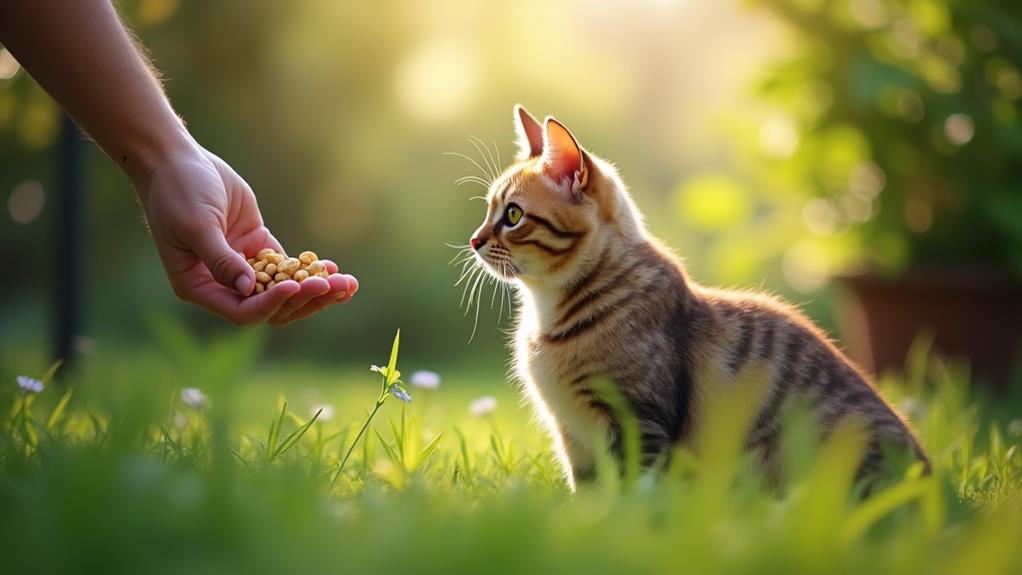
After you've established a consistent feeding routine, it's crucial to focus on developing gradual human interaction with the semi-feral cat. Begin by allowing the cat to approach you at its own pace. This approach fosters trust as you're showing patience and respect for its boundaries. Use non-threatening body language and soft vocalizations to convey a sense of safety and comfort. Avoid making direct eye contact initially, as cats may perceive this as a threat. Instead, slow blinking can communicate non-aggression and help the cat feel more at ease.
To encourage the cat to come closer, offer treats or wet baby food on a spoon. This makes the interaction positive and rewarding without forcing physical contact. It's vital to create a routine for these interactions, as consistency will help the cat anticipate positive experiences and gradually build confidence in your presence.
Introduce gentle movements and sounds over time, allowing the cat to acclimate to your presence. Pay attention to its comfort level and adjust your actions accordingly. By following these steps, you're paving the way for a trusting relationship, where the cat feels secure and positive interactions become a regular part of its routine.
Respecting Personal Space
How can you guarantee a semi-feral cat feels comfortable in your presence? Start by respecting their personal space. It's significant to interact without overwhelming them, allowing the cat to approach you on their terms. Here's how you can build trust and foster comfort:
- Provide a Safe Hiding Spot: Make certain the cat has a place to retreat when feeling stressed. This helps them feel secure and gradually more at ease in your presence.
- Maintain a Calm Demeanor: Avoid sudden movements, as they can trigger a fight or flight response. Your calmness will reassure the cat that you're not a threat.
- Keep a Safe Distance: Initially, stay at a comfortable distance. Let the cat decide when to close the gap, emphasizing their control over the interaction.
- Spend Time Nearby: Simply being in the same area without forcing interaction helps the cat get used to your presence, which is vital for building trust.
- Use Familiar Scents: Leave worn clothing near their space. The scent will provide comfort and make your presence feel less intrusive.
Using Calming Aids
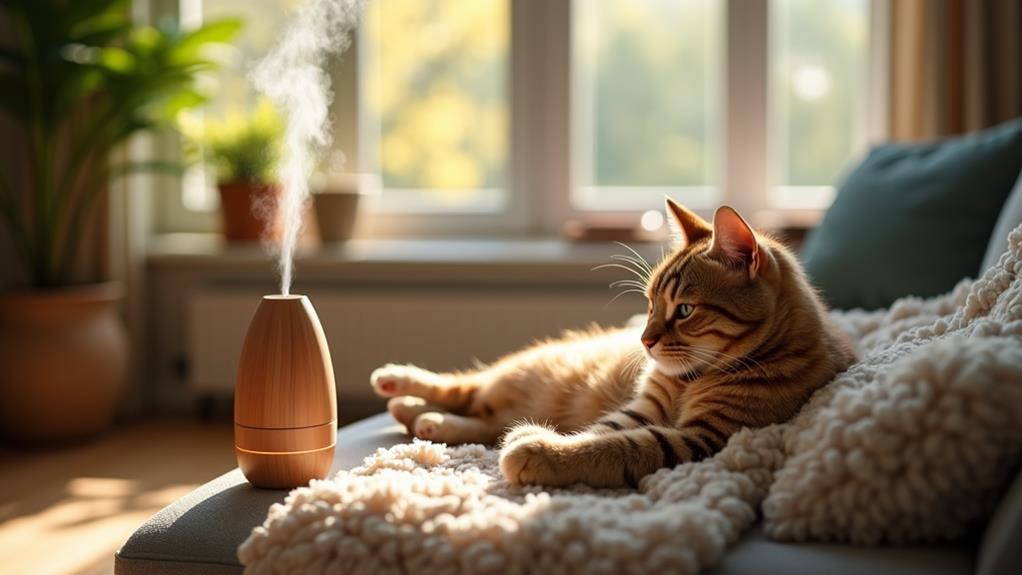
Beyond respecting a semi-feral cat's personal space, using calming aids can greatly improve their comfort in a new environment. Non-pharmaceutical options like pheromone sprays and calming supplements are excellent tools for reducing adjustment stress. Products such as Feliway mimic natural feline pheromones, creating a sense of familiarity and comfort for your feline companion. When these pheromones are present in their environment, cats often feel more at ease, making the space more inviting.
Incorporating catnip is another effective strategy. It can induce calmness and even playfulness in some cats, helping to establish a positive experience when they're around you. By gradually introducing catnip during feeding times, you reinforce these positive associations, further reducing their anxiety. This method not only helps in creating a relaxed atmosphere but also encourages the cat to associate your presence with something enjoyable.
Always monitor the cat's reactions to these calming aids. Since each cat is unique, effectiveness can vary. It's important to observe how your cat responds and adjust your approach accordingly. Finding the right combination of calming aids will foster trust and help you build a stronger bond with your semi-feral friend.
Celebrating Small Milestones
Recognizing and celebrating small milestones is key to building trust with a semi-feral cat. Each tiny step they make toward you is a big leap in their world. When the cat approaches closer during feeding times or makes eye contact, these are moments to celebrate. Acknowledge these achievements with gentle praise or a treat to reinforce their progress. This gradual progress is crucial, and documenting each milestone will help you see how far you've come together.
Consider these actions to deepen the bond:
- Approaching You: Celebrate when the cat allows you to be within a few feet. Offer a small reward like a treat to reinforce this trust.
- Vocalization: If the cat starts vocalizing in your presence, respond with soft words or treats to encourage communication.
- Eye Contact: Making eye contact is a big trust signal. Acknowledge it with a calm environment, encouraging further engagement.
- Sitting Near You: When the cat sits near you, celebrate by creating a cozy space with toys, enhancing their sense of security.
- Curiosity and Play: If they show curiosity or engage in gentle play, reward this behavior to strengthen the bond.

